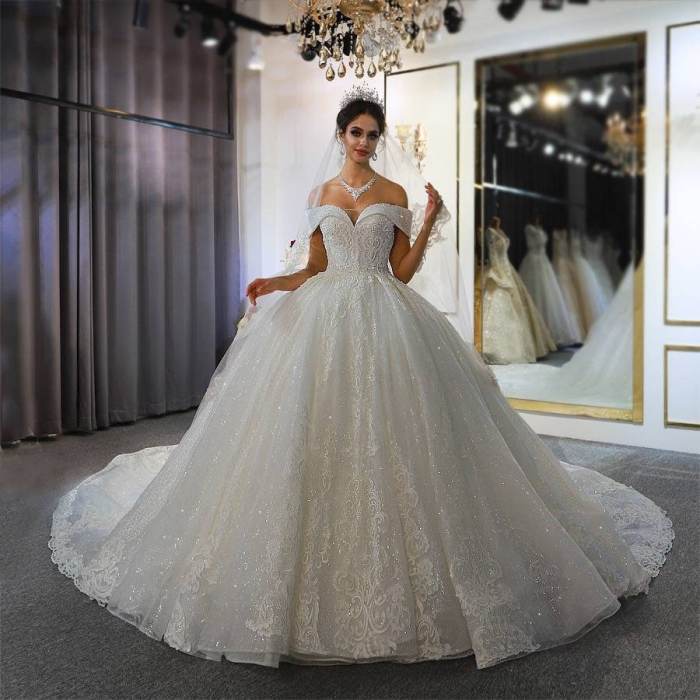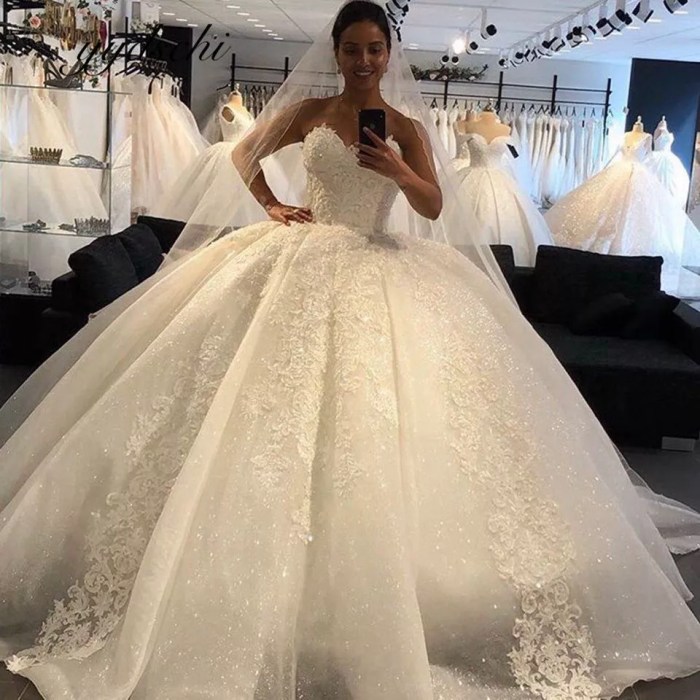Wedding Ball Gown Dresses: A Comprehensive Guide
Wedding ball gown dress – The wedding ball gown, a timeless symbol of bridal elegance, continues to captivate brides with its romantic and dramatic silhouette. This guide delves into the various aspects of choosing, understanding, and styling this iconic wedding dress, providing a comprehensive overview for the modern bride.
Styles and Trends of Wedding Ball Gown Dresses

Source: etsystatic.com
Ball gown styles have evolved significantly over time, influenced by fashion trends and societal changes. Understanding these styles and current trends is crucial for a bride selecting her perfect dress.
| Style | Silhouette | Suitable Body Types | Typical Embellishments |
|---|---|---|---|
| A-Line | Fitted at the bodice, gradually widening to the floor | Most body types; particularly flattering on pear and hourglass figures | Lace appliqués, beading, embroidery |
| Princess | Fitted bodice with a full skirt starting from the shoulders | Most body types; especially flattering on petite brides | Simple embellishments, satin bows, delicate beading |
| Mermaid | Fitted from the bodice to the knees, flaring out dramatically at the bottom | Hourglass and athletic figures | Intricate beading, lace, dramatic train |
| Ballgown | Fitted bodice with a full, voluminous skirt | Most body types; can be adjusted with corsetry | Lace, tulle, embroidery, beading, sequins |
Current trends in wedding ball gowns favor luxurious fabrics such as silk charmeuse and mikado, alongside delicate tulle and lace. Popular colors extend beyond traditional white, with blush pinks, ivory, and champagne shades gaining prominence. Embellishments are increasingly intricate, featuring hand-beaded details, delicate embroidery, and 3D floral appliqués.
Over the past 50 years, ball gown styles have seen a shift from the heavily structured, voluminous gowns of the 1970s to the more streamlined and modern silhouettes of today. The 1980s saw a rise in puffy sleeves and dramatic trains, while the 1990s brought a more minimalist approach. The 2000s saw a resurgence of romantic details and lace, leading to the diverse range of styles available today.
Fabric and Construction of Wedding Ball Gowns
The choice of fabric significantly impacts the drape, feel, and overall look of a wedding ball gown. Understanding fabric properties is essential for selecting a dress suitable for the season and climate.
Silk, known for its luxurious drape and sheen, is a popular choice for formal weddings. Satin, offering a smooth and glossy finish, is ideal for creating a sleek and sophisticated look. Tulle, a lightweight and airy fabric, adds volume and texture to the skirt. Lace, a delicate and intricate fabric, is often used for embellishment and can be incorporated into the entire gown.
Construction techniques play a vital role in achieving the desired structure and support of a ball gown. Boning provides shape and structure to the bodice, while corsetry creates a defined waistline. Petticoats add volume and fullness to the skirt, enhancing the overall silhouette.
Silk charmeuse drapes softly and flows beautifully, creating a romantic and ethereal look. Satin offers a more structured drape with a distinct sheen, lending itself to a more formal and elegant style. Tulle, due to its lightness, creates a voluminous and airy effect, ideal for creating a full, princess-style skirt. The differences in drape and feel contribute significantly to the overall aesthetic of the gown.
Choosing the Right Wedding Ball Gown

Source: ebayimg.com
Selecting a wedding ball gown requires careful consideration of several key factors to ensure the dress complements the bride’s personal style and the wedding’s overall aesthetic.
- Body type: Choose a silhouette that flatters your figure.
- Venue: Consider the formality and setting of the wedding.
- Personal style: Select a design that reflects your taste and personality.
- Budget: Set a realistic budget and stick to it.
- Season and climate: Choose fabrics appropriate for the weather.
Professional alterations are crucial for achieving the perfect fit and ensuring the gown looks its best on the big day. A skilled seamstress can adjust the length, shape, and size of the dress to create a flawless silhouette.
A well-defined process for selecting and purchasing a wedding ball gown ensures a smooth and enjoyable experience. This process typically involves browsing styles, scheduling appointments, trying on dresses, making a decision, and finalizing alterations.
Accessories and Styling for Wedding Ball Gowns
Accessories and styling choices significantly impact the overall look of a bride wearing a ball gown. Careful consideration of these elements can enhance the gown’s beauty and create a cohesive bridal aesthetic.
- Veils: A cathedral-length veil adds drama, while a birdcage veil offers a vintage touch.
- Jewelry: Delicate necklaces and earrings complement the gown’s details.
- Shoes: Elegant heels or delicate sandals complete the look.
Hairstyles and makeup should complement the gown’s style and the bride’s features. An updo can showcase the neckline, while loose curls add a romantic touch. Makeup should be elegant and enhance the bride’s natural beauty.
Factors to consider when choosing accessories include the overall style of the dress, the venue, and the time of year. A simple gown might require more elaborate accessories, while an intricately embellished gown might require minimal additions.
Illustrative Examples of Wedding Ball Gowns, Wedding ball gown dress
Visualizing different ball gown styles can help brides make informed decisions. These descriptions offer a glimpse into the diversity and beauty of ball gowns.
Imagine a classic ivory ball gown crafted from luxurious silk charmeuse. The A-line silhouette flows gracefully to the floor, accentuated by delicate lace appliqués cascading down the skirt. A sweetheart neckline and cap sleeves add a touch of romance, complemented by a chapel-length train that trails elegantly behind.
Picture a blush pink princess-style gown made of delicate tulle, creating a soft and romantic look. The full skirt is embellished with embroidered floral motifs, adding a touch of whimsy. A fitted bodice with a V-neckline accentuates the bride’s figure, while delicate spaghetti straps add a touch of elegance.
Envision a dramatic mermaid gown crafted from mikado silk, exuding sophistication and glamour. The fitted bodice accentuates the waistline, leading to a dramatic flare at the knees. Intricate beading and sequins adorn the bodice and skirt, adding sparkle and shine. A long train adds a touch of regal elegance.
Necklines, sleeves, and trains significantly impact the overall aesthetic. A sweetheart neckline adds romance, while a high neckline offers a more modest look. Sleeves can add coverage or enhance the shoulders. A long train adds drama and elegance.
The interplay of fabrics and embellishments creates various textures and visual effects. The combination of lace and tulle creates a delicate and airy look, while beading and sequins add sparkle and shine. The choice of fabrics and embellishments significantly impacts the overall feel and visual impact of the gown.
Commonly Asked Questions: Wedding Ball Gown Dress
How much should I budget for a wedding ball gown?
Prices vary widely depending on designer, fabric, and embellishments. Set a realistic budget early in your search.
When should I start shopping for my wedding ball gown?
Ideally, begin 9-12 months before your wedding to allow ample time for alterations and potential delays.
Can I wear a ball gown if I’m not tall?
Absolutely! Choosing the right silhouette and heel height can create a flattering look for any height.
How do I care for my wedding ball gown after the wedding?
Professional cleaning and preservation are recommended to maintain its condition for years to come.
